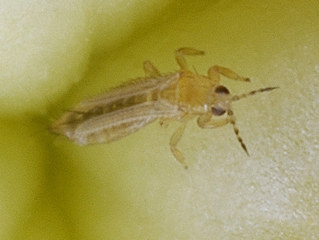Onion thrips
Description
Thrips tabaci and western flower thrips Frankliniella occidentalis are sap feeders. Common thrips as in the main image; Order: Thysanoptera, Family: Thripidae. They are extremely small and are difficult to spot, even by experts. They are experts in blending in and are shorter than 1.5mm. There are about 4500 species of thrips. Both winged and wingless forms occur, sometimes in the same species.
The common thrips specie is a sap feeder to the frustration of growers, however, there are some good species that are predators, believe it or not. They feed on mites, aphids and other small arthropods. There are even some species that feed on fungi and decaying matter. Any grower should therefor consider biological control before using strong pesticides.
They can be found everywhere, in the fields around the greenhouse, bark of trees, debri, flowers of weeds and more.
Damage
Several leaf damage, particularly important as vector of tomato spotted wilt virus. The transmittance of viruses is the main concern of thrips. Because the are so small and numerous, they are hard to find and once identified, the virus has already been spread throughout the crop.
Thrips is a big problem on onions and if not controlled can cause significant yield losses. Tissue scarring is also problematic in green onions. Serious infestations can reduce onion yields as well as shelf life.
On tomatoes and other solanaceae thrips is an ideal vector for viruses (tomato-spotted wilt virus).
Damaged foliage can easily be identified by its speckled or streaked silver appearance. Flowers are distorted and blotched or streaked with white or brown marks.
Control
- Cultural: Screen vents and doorways
- Monitor: Blue or yellow sticky traps throughout the growing area.
- Biological: Amblyseius sp. Spray oils such as kaolin, canola oil, garlic oil and insecticidal soap.
- Chemical:
Predators are lacewings, lady beetles and predatory mites (which can be bought commercially).




